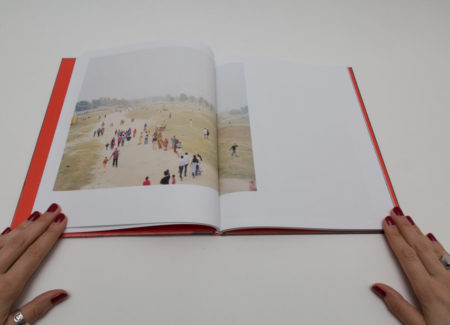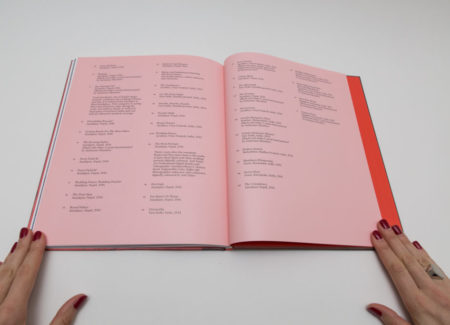JTF (just the facts): Published in 2017 by Chose Commune (here). Hardcover, 110 pages, with 116 color and black and white photographs, some hand-painted. Includes a narrative text by Arshia Sattar. In an edition of 1000 copies. (Cover and spread shots below.)
A website for the larger project, entitled A Myth of Two Souls, can be found here.
Comments/Context: In 2017, the French photographer Vasantha Yogananthan received the ICP Infinity Award for an emerging photographer for his ambitious and exciting project inspired by the Ramayana, the ancient Indian epic poem. The epic tells the love story of Rama and Sita (and a series of trials) in seven chapters. It was first recorded more than two thousand years ago and it is one of the founding epics of Hindu mythology. The book Early Times (reviewed here) was published in 2016 and became the first chapter of the long term project which ultimately will have seven books under a broader title A Myth of Two Souls. In 2017 Yogananthan released the second chapter, The Promise.
Yogananthan first learned about the Ramayana at an early age, as his father, originally from Sri Lanka, used to tell him tales from the epic. These stories were full of magic, heroism, powerful gods, true love and unforgettable adventures. He came across the book again later in his life, and realized “how contemporary it is and how much it tells about the country and its people”. When he visited India in 2013, he found the ancient folklore and legends closely intertwined with everyday life. A Myth of Two Souls offers an artistic interpretation of the Ramayana through photography, placing it directly into contemporary Indian society. As there are already countless retellings of the epic, Yogananthan decided to incorporate the classic narrative by collaborating with Indian writers and artists. He commissioned a different writer for each chapter, and a number of the photographs, originally shot in black and white, have been colored by Indian artists using the ancient technique of “hand-painting”.
While Early Times recounts the story of Rama and Sita before they met and fell in love, the second book, The Promise, celebrates their love. It has a different format and execution, yet it also keeps the necessary continuity. Yogananthan employs a variety of approaches to construct his magically timeless story: soft creamy colours, hand-painted and illustrated photographs, and even vernacular materials.
As a photobook, The Promise has an elegant design, an elaborate concept and excellent print quality. Its cover immediately grabs attention: an old-fashioned wedding portrait of Rama and Sita appears in full bleed with a red shimmer. The book omits page numbers but thoughtfully numbers the images picking up from the first book, symbolically marking the continuation of the narrative. The layout plays an essential role in building the dynamic. The main text (rewritten by Arshia Sattar) appears throughout the book in light pink, placing the images specifically inside the existing plot of the Ramayana.
Yogananthan likes to mix the elements of magical legend and modern reality. The key scenes from the Ramayana once again are recreated with local encounters, bringing a modern twist to the visual narrative. These theatrical portraits add a surreal feel to the story.
The book opens with a dreamy landscape of a foggy morning over a stream; it is rather small and is placed in the lower left corner of the spread. Rama and Lakshmana train in archery, a symbolic moment of becoming men. An illustration “First Glimpse” marks the moment when Rama and Sita first saw each other. It is followed by a photograph of bird in a cage titled “lovebird”. As the epic goes, Sita decided she would marry the prince who could bend the bow. One of the next spreads is a photo of Sita watching the bow contest (she is in the forest comfortably leaning against a fallen tree). It is paired with the photo of Rama “bending Shiwa’s bow”. The bow symbolizes God’s, or in Western context Cupid’s, arrow. Rama easily breaks the bow in two, and they fall in love. The photograph shows them sitting on the stairs of a house; Rama holds Sita’s hand while she looks straight ahead.
As the story progresses, the images get bigger and reach their highest point with the wedding. Full spread photographs are colorful and printed on glossy paper. Wedding festivities are documented through the images of a royal castle, crowds of happy people, food and, of course, fireworks. One of them shows rows of red chairs in the open air with bright decorative lights over, and another depicts a massive gathering of people in colorful outfits with a few of them dancing. There is a sense of celebration and happiness. A portrait of the couple (first seen on the cover) appears in the middle of the book, on paper ⅔ shorter than other pages, placing them literally in the middle of the festivities.
A few years later, the king decides to step down and Rama, the eldest son, is naturally in line to take the throne. But his stepmother has manipulated the king to let her son be the successor, and so Rama is exiled from the country for fourteen years. Sita follows Rama to the forest: “What does our love mean, Rama, if I do not come with you to the forest?”. The last image captures Rama and Sita standing in the park/forest gently hugging; it is small and placed in the lower right corner of the spread, marking the full cycle of the chapter.
Yogananthan composes his narrative by interweaving various layers of the story, masterfully mixing fiction and reality. The second book gives a better sense of A Myth of Two Souls as a project, its scale and creativity. Yogananthan keeps the essential continuity of the narrative and finds creative ways to continually make it exciting and alive. In many ways, he has developed a unique approach to photographic storytelling. This enchanting story is just getting started and it will be exciting to see where Yogananthan’s imagination will take it next.
Collector’s POV: Vasantha Yogananthan does not appear to have gallery representation at this time, so interested collectors should likely follow up directly via his website (linked in the sidebar).



















